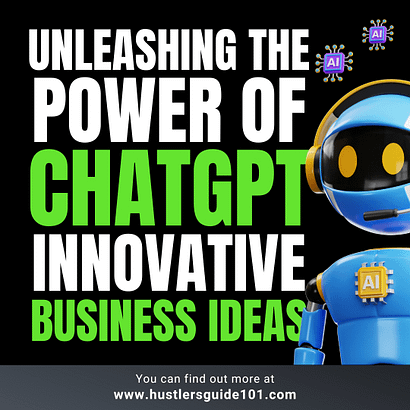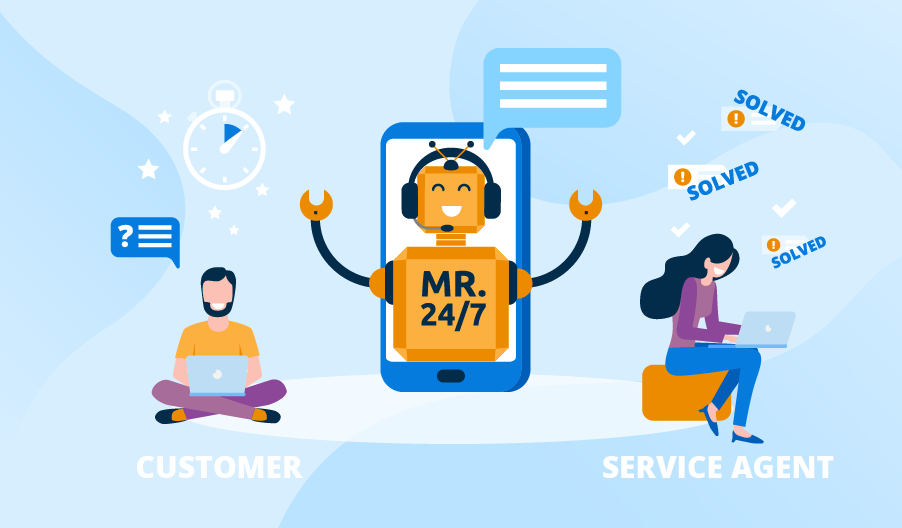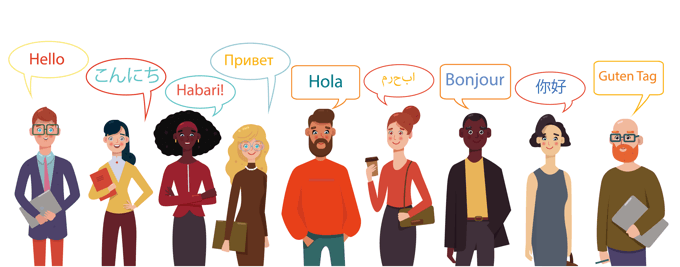
Are you tired of looking for the perfect business idea that can help you stand out in a crowded market? Or searching for ideas that do not require much investment and you can start from the corner of your room? Well, I have the perfect solution for you. ChatGPT Business Ideas You Can Start with ZERO Investment.
The best part? The potential ChatGPT business ideas are endless. So why not explore the world of artificial intelligence and discover how it can help you create a business in today’s world?
ChatGPT Business Ideas
The world of business is constantly evolving, and ChatGPT technology has become an essential tool for entrepreneurs and businesses of all sizes. With this in mind, it’s important to explore ChatGPT business ideas and how they can help you stay ahead of the competition.
Chatbots for Customer Service
If you’re thinking of starting a customer service business, using ChatGPT to create a chatbot could be a game-changer. Chatbots powered by ChatGPT can handle a variety of customer service tasks such as answering frequently asked questions, providing product recommendations, and even processing orders.

Here are some simple steps to help you get started:
Step 1: Train Your Chatbot
Use ChatGPT to train your chatbot to understand the specific needs of your business and industry. You can create different training sets for various customer scenarios, ensuring that your chatbot can provide personalized assistance.
Step 2: Choose a Platform
Select a platform that suits your business needs, and integrate ChatGPT into it. Many popular customer service platforms offer easy integration with chatbots, so choose one that works best for you.
Step 3: Design Your Chatbot Interface
Create an intuitive and user-friendly interface that provides customers with a seamless experience. Your chatbot interface should be easy to navigate and offer features like quick response times, natural language processing, and personalized recommendations.
Step 4: Provide Excellent Customer Support
Ensure that your chatbot is equipped to handle customer inquiries promptly and efficiently. Your chatbot should be able to provide timely and accurate responses to customer queries, which will help build customer loyalty and trust.
Language Translation
With its advanced natural language processing capabilities, ChatGPT can be trained to understand and translate languages accurately. You can use this to your advantage and create a Language Translation tool.

Here are some steps to help you get started:
Step 1: Determine Your Target Languages
Decide on the languages you want your app to support. Once you have selected the languages, you can use ChatGPT to train your app to recognize and translate them accurately.
Step 2: Choose a Platform
Decide on the platform you want to develop your app on, such as iOS or Android. You can then integrate ChatGPT into your app development process.
Step 3: Design Your App Interface
Create an intuitive and user-friendly interface that makes it easy for users to input text, select languages, and view translations. The app should also offer features like voice input and output, natural language processing, and multilingual support.
Step 4: Train Your Chatbot
Use ChatGPT to train your app to understand and translate languages accurately. You can create different training sets for different languages and dialects to ensure that your translations are accurate and culturally appropriate.
Step 5: Test Your App
Test your app thoroughly to ensure that it provides accurate translations and a seamless user experience.
Content Creation
ChatGPT can generate high-quality content, including articles, social media posts, and product descriptions, that’s unique and engaging. What if you could turn this into a business? Amazing, right? Let’s take a look at it.

Step 1: Identifying your target audience
Identify your target market and the type of content you want to generate. This will help you determine the features and functionality you need to include in your content creation tool.
Step 2: Access to NLP
Sign up for an API key with OpenAI to access ChatGPT’s natural language processing technology.
Step 3: Creating templates and prompts
Use ChatGPT to create templates and prompts that will guide users in generating their content. These templates can be customized based on the user’s preferences, including tone, style, and keywords.
Step 4: Make it exceptional
Add additional features to your content creation tool, such as SEO optimization, image and video suggestions, and content scheduling.
Step 5: Testing and adjustments
Test your content creation tool to ensure that it generates high-quality, unique content. You may need to make adjustments to your templates and prompts to improve the output.
Step 6: Time to launch
Launch your content creation tool and market it to businesses and individuals looking to create high-quality content quickly and efficiently.
App Development
With its advanced natural language processing technology, ChatGPT can help you develop an app without any coding skills. From idea generation to launch, ChatGPT can guide you through every step of the process.

Here are the steps you can consider to bring your idea to life:
Step #1: Determine your app’s purpose and functionality
Before you begin developing your app, it’s important to have a clear understanding of what you want it to do. Will it be a language translation app, a personal shopping assistant, or something else entirely? Make sure you have a detailed plan in place before you start developing.
Step #2: Choose a development platform
There are many different development platforms available, such as Android Studio or Xcode. Choose a platform that is compatible with the programming language you plan to use.
Step #3: Set up your development environment
Once you have your platform selected, it’s time to set up your development environment. This will include installing any necessary software and configuring your development environment.
Step #4: Write your code
This is where the real work begins! Use your chosen programming language to write the code for your app. Make sure to incorporate the ChatGPT API into your code to take advantage of its natural language processing capabilities.
Step #5: Test and debug
Once you have written your code, it’s important to thoroughly test and debug your app to ensure it functions properly.
Step #6: Launch your app
After you have thoroughly tested your app, it’s time to launch it! Publish your app to the app store and start promoting it to your target audience.
Creating Courses
Another great idea in our bag of ChatGPT business ideas is creating courses. Whether you want to teach a language, a technical skill, or a creative subject, ChatGPT can assist you in developing a comprehensive and interactive course.

Let’s explore how you can use ChatGPT to create a course that stands out in today’s competitive e-learning market.
Step #1: Define the course topic:
The first step is to identify the subject matter of your course. Once you have a topic in mind, you can start thinking about the content that needs to be included.
Step #2: Collect relevant information
Start researching and gathering information about the topic. You can use a variety of sources like books, articles, videos, and podcasts. Be sure to organize the information in a structured way.
Step #3: Create an outline
Once you have the information, create an outline of the course content. Divide the content into modules or sections, and create an overview of what each module will cover.
Step #4: Use ChatGPT to generate content
Use ChatGPT to generate content for your course. You can use the tool to create blog posts, articles, summaries, and more. Use the content to fill in the details of your course outline.
Step #5: Edit and revise the content
Once you have the content, review it to ensure that it meets the quality standards. Edit and revise the content to ensure that it is accurate, clear, and engaging.
Step #6: Create additional materials
In addition to the content, you can create additional materials like quizzes, exercises, and assignments. These materials will help reinforce the learning outcomes of your course.
Step #7: Host the course
Finally, you can host your course on a platform like Udemy or Coursera, or you can host it on your own website. Promote the course on social media and other channels to reach your target audience.
Advantages of ChatGPT in Business
ChatGPT technology has many advantages that can benefit businesses in a variety of ways. Here are some of the key advantages of using ChatGPT in business:
Increased efficiency and productivity
ChatGPT technology can automate many repetitive and time-consuming tasks, freeing up staff to focus on more complex and strategic work. This can increase overall efficiency and productivity, and allow businesses to operate more effectively.
Improved customer experience and satisfaction
ChatGPT can provide customers with quick and personalized assistance, which can lead to improved customer satisfaction and loyalty. By providing round-the-clock customer support and responding to inquiries in real time, businesses can enhance the overall customer experience.
Cost-effectiveness and scalability
ChatGPT can be a cost-effective way for businesses to handle customer inquiries and support requests. By automating many processes and reducing the need for human support, businesses can save on staffing costs and scale up their operations more easily.
Ability to handle a large volume of requests
ChatGPT technology can handle a large volume of requests simultaneously, without the need for additional staffing or resources. This makes it an ideal solution for businesses that receive a high volume of inquiries or support requests.
Challenges of Implementing ChatGPT in Business
While ChatGPT technology offers many benefits for businesses, several challenges must be addressed when implementing it into existing systems. Here are some key challenges that businesses may face when integrating ChatGPT:
Integration and compatibility with existing systems
One of the biggest challenges of implementing ChatGPT is ensuring that it integrates smoothly with existing systems and software. This requires careful planning and coordination between IT teams and other stakeholders.
Data privacy and security concerns
Another challenge is ensuring that customer data is kept secure and protected. ChatGPT technology collects and processes large amounts of data, and businesses must take steps to protect this data from cyber threats and breaches.
Technical expertise and training required
Implementing ChatGPT requires technical expertise and training, which can be a challenge for businesses that do not have in-house IT teams or the resources to hire outside experts. Businesses must invest in training and development to ensure that their staff is equipped to handle ChatGPT technology.
Ethical Considerations and potential bias
ChatGPT technology has the potential to perpetuate bias or discrimination if not carefully designed and implemented. Businesses must be aware of these risks and take steps to ensure that their chatbots and AI systems are ethical and unbiased.
Future of ChatGPT in Business
The future of ChatGPT in business looks incredibly promising, with several exciting developments on the horizon. Here are some key factors driving the growth of ChatGPT in business:
Advancements in natural language processing technology
As natural language processing technology continues to advance, the accuracy and speed of ChatGPT technology will only improve. This will enable businesses to provide even more personalized and effective customer service, automate more complex business processes, and gain deeper insights into their target audience.
Increased adoption of ChatGPT in various industries
ChatGPT technology is being increasingly adopted by businesses across a wide range of industries, from healthcare and finance to retail and e-commerce. As more businesses begin to see the benefits of using ChatGPT, we can expect to see even greater innovation and growth in this area.
Potential for ChatGPT to transform customer service and business operations
ChatGPT has the potential to completely transform the way businesses operate and interact with customers. With the ability to automate customer service, streamline business processes, and provide personalized experiences, ChatGPT can help businesses to save on costs, increase efficiency, and improve overall customer satisfaction.
Hot FAQs regarding ChatGPT business ideas
What are the best business uses of ChatGPT?
The best business uses of ChatGPT include automating customer service, improving lead generation and sales, and enhancing the overall customer experience. With ChatGPT, you can save on costs and increase efficiency while providing 24/7 support to your customers.
How can I grow my business with ChatGPT?
ChatGPT can also be used to conduct market research by analyzing data and identifying trends. By collecting and analyzing data from customer interactions, you can gain valuable insights into their preferences, pain points, and behavior. This information can be used to create more targeted marketing campaigns, improve products and services, and make informed business decisions.
How do I use ChatGPT for social media?
Using ChatGPT for social media involves developing a chatbot that can engage with your followers, answer questions, and provide support. You can also use ChatGPT to automate social media posts, analyze social media data, and target specific audiences with personalized messages.
Wrapping up
It’s time to wrap up our journey into the world of ChatGPT business ideas, and what a ride it’s been! From learning about the importance of improving customer service and streamlining business processes to exploring different ventures like creating a chatbot app or developing a ChatGPT course, we’ve covered a lot of ground.
But let’s be real – the best part has been discovering the potential for success and growth with ChatGPT technology. The numbers don’t lie – with the chatbot market expected to grow at a rate of 29.7% and the e-learning market projected to reach $325 billion by 2025, the sky’s the limit.
Let’s go forth and conquer the world with ChatGPT business ideas!
Also read: 16 SCALABLE BUSINESS IDEAS YOU CAN START TODAY [UPDATED 2023]







